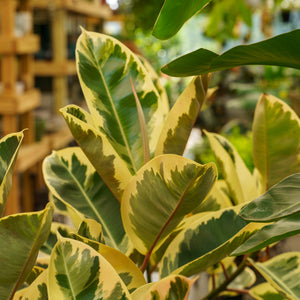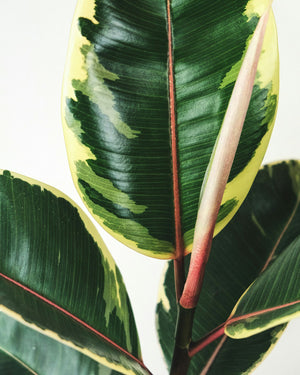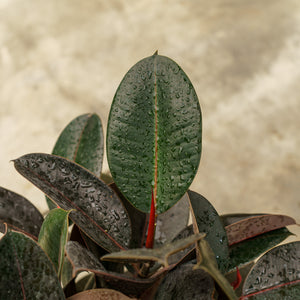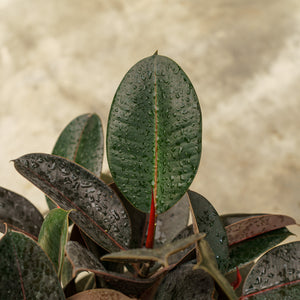The Ficus Guide
Ficus is a diverse genus of trees and shrubs commonly used as houseplants for their striking foliage and architectural presence. With glossy leaves, unique forms, and air-purifying properties, ficus plants have long been a staple in both home and office décor. Some species, like the iconic fiddle-leaf fig (Ficus lyrata), can grow into dramatic indoor trees, while others, like Ficus benjamina, offer graceful, weeping forms ideal for corner placement.

About
The Ficus genus, part of the Moraceae family, encompasses more than 800 species. Native to tropical and subtropical regions, these plants vary widely in size and appearance—from small, upright bushes to sprawling canopy trees in the wild. While often grown indoors in cooler climates, many ficus species are trees in their natural habitats.
Popular indoor types include:
- Ficus lyrata ('Bambino' and standard) – The fiddle-leaf fig, known for its large, violin-shaped leaves.
- Ficus elastica ('Tineke', 'Shivereana', 'Burgundy', 'Belize') – Commonly called the rubber plant, with thick, glossy leaves that come in green or variegated forms.
- Ficus benjamina and its cultivars ('Starlight') – Known for graceful, arching branches and delicate leaves.
- Ficus triangularis variegata – With unique triangle-shaped variegated leaves.
- Ficus benghalensis 'Audrey' – A trendy alternative to the fiddle-leaf fig with velvety leaves and a more forgiving nature.
- Ficus umbellata – A rarer choice with broad, heart-shaped leaves.
Each type brings a different personality to indoor spaces, offering solutions for vertical interest, light filtering, or design focal points.

PLANTING
Ficus species grown indoors prefer well-drained soil, consistent warmth, and thoughtful placement to prevent stress:
- USDA Hardiness Zones: Most ficus houseplants are not cold-hardy and are grown indoors year-round in Zones 9 and colder. Outdoors, some species can thrive in Zones 10–12.
- Soil: Use a well-draining indoor potting mix enriched with perlite or bark. Avoid heavy soils that retain excess moisture.
- Sunlight: Bright, indirect light is ideal. Ficus can adapt to filtered sunlight, but poor lighting causes leaf drop and stunted growth.
- Watering: Water thoroughly when the top 1–2 inches of soil feels dry. Avoid letting the plant sit in water.
- Container & Drainage: Ensure pots have drainage holes. Terra cotta pots can help prevent overwatering by allowing soil to breathe.
Place away from cold drafts, heating vents, and areas with drastic temperature changes, all of which can trigger stress and leaf drop.

CARE
Caring for a ficus plant means consistency. These plants dislike sudden changes but will thrive with regular care:
- Watering: Water when the topsoil is dry, and reduce frequency in winter. Underwatering causes leaf drop; overwatering causes root rot.
- Humidity: Ficus plants appreciate humidity—especially Ficus lyrata. Mist the leaves or use a humidifier if air is dry.
- Fertilizing: Use a balanced houseplant fertilizer once per month during the growing season (spring through early fall).
- Pruning: Prune to maintain shape, remove dead growth, or control size. Use clean, sharp shears and trim just above a node.
- Cleaning Leaves: Wipe dust from leaves with a damp cloth to improve light absorption and prevent pests.
- Repotting: Repot every 2–3 years or when the plant becomes rootbound. Spring is the best time.
Ficus can be sensitive to change. Avoid moving them frequently or shifting their light exposure dramatically.

HOW TO USE
Ficus plants serve both functional and aesthetic roles in interior design. Their lush foliage and strong form make them impactful:
- Statement Plants: Large Ficus lyrata, Ficus 'Audrey', or Ficus altissima varieties make ideal corner plants or focal points in living rooms or entryways.
- Compact Spaces: Use compact types like Ficus lyrata 'Bambino' or Ficus triangularis variegata on desks, countertops, or shelves.
- Bright Offices: Rubber plants (Ficus elastica) are tolerant of varied light and excellent for office environments.
- Minimalist Interiors: Pair the clean lines of ficus with modern furniture and neutral tones to enhance their sculptural impact.
Complement ficus with low-maintenance companions like snake plants, ZZ plants, pothos, or philodendrons for a well-rounded indoor collection.

COMMON QUESTIONS
- Are ficus poisonous to cats? Yes, many ficus species are toxic to cats if ingested, causing oral irritation and digestive upset.
- Are ficus poisonous to dogs? Yes, ficus can also be toxic to dogs. Keep plants out of reach if your pets are curious chewers.
- How to care for a ficus? Provide bright, indirect light, regular but moderate watering, and consistent conditions without drafts or frequent moves.
- How to trim a ficus tree? Use sharp shears to trim back leggy or uneven branches, cutting just above a leaf node. Prune in spring for best results.
- How to propagate ficus? Most ficus propagate via stem cuttings. Take a 4–6 inch cutting with at least one node, root in water or moist soil, and cover for humidity.
Conclusion
Ficus plants remain a timeless choice for plant lovers seeking sculptural beauty and lush foliage indoors. Whether you’re drawn to the dramatic fiddle-leaf fig, the classic rubber plant, or the charming triangle ficus, there’s a variety that suits every style and light condition. While they can be a bit finicky at first, patience and consistency will reward you with healthy, long-lived companions.
The Ficus Collection
Sold Out
Sold Out
Sold Out
Sold Out
Sold Out






